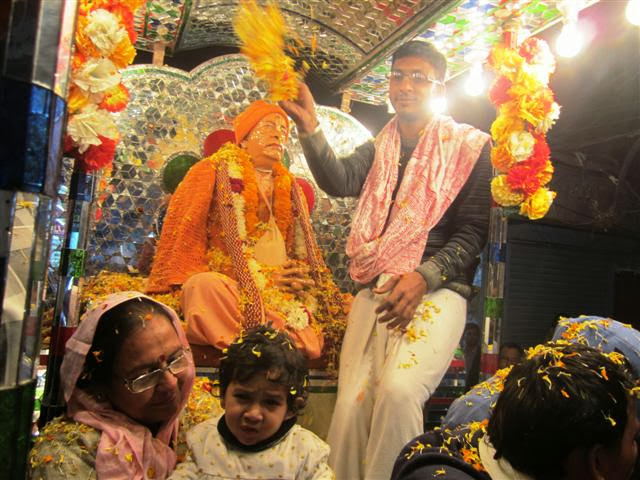The Very Best Day of My life
Walking Dead Carrot – Prahladananda Swami – A Humorous Take On Modernism (3 min video)
→ Dandavats.com
 A Humorous Take On Modernism Read more ›
A Humorous Take On Modernism Read more › 17 Dec 2013 – Katyayani Vrata Ends
→ ISKCON Desire Tree
44th Anniversary of Sri Sri Radha Londonisvara (Album 21 photos)
→ Dandavats.com
 44th Anniversary of Sri Sri Radha Londonisvara Read more ›
44th Anniversary of Sri Sri Radha Londonisvara Read more › A year of eating vegetarian food in Ireland, my favorite veg restaurants
→ Dandavats.com
 With locations across central Dublin, Govindas is a great place to stop into for lunch. You walk up to the counter and ask for a regular or large plate, and the kind soul serving you proceeds to pile it high with homemade Indian-ish tasty glop. Their food isn’t as intensely flavorful as traditional Indian, but it’s so cheap and satisfying (and the soft Hare Krishna chanting playing in the background is so soothing) that I’m never disappointed Read more ›
With locations across central Dublin, Govindas is a great place to stop into for lunch. You walk up to the counter and ask for a regular or large plate, and the kind soul serving you proceeds to pile it high with homemade Indian-ish tasty glop. Their food isn’t as intensely flavorful as traditional Indian, but it’s so cheap and satisfying (and the soft Hare Krishna chanting playing in the background is so soothing) that I’m never disappointed Read more › O’ VAISNAVA GOSWAMI
→ simple thoughts
Vicaru das
ISKCON uk
O’ Vaisnava Goswami please be merciful to me now ,there is no one except you who can purify the fallen souls.where does anyone find such a merciful personality by whose mere audience all sins go far away/.After bathing in the waters of the sacred Ganges many times one becomes purified.,but just by the sight of you, the fallen souls are purified,This is your great power
The holy name delivers one who has committed an offence to Lord Hari, but if one commits an offence to you, there is no means of deliverance,Your heart is always resting place of Lord Govinda and Lord Govinda says,The vaisnavas are in my heart,
I desire the dust of your holy feet in every birth I may take ,./Please consider Narottam yours, and be kind upon him
NOTHING GOES FURTHER WITHOUT MERCY
→ simple thoughts
VICARU DAS
BHAKTIVEDANTA MANOR
ISKCON UK
Gurudava,By a drop of your mercy make this servant of yours more humble than a blade of grass.Give me strength to bear all trials and troubles,and free me from all desires for personal honour.
O lord and master Invest me with the power to properly honor all living beings.Only then will I sing the holy name in great ecstasy and
will all my offences cease.
O lord and master’ when will this devotee be blessed by obtaining your mercy/ I am low fallen and devoid of all strength and intelligence.Please make me your beloved servant.
When I examine myself,I find nothing of value,your mercy is therefore essential to me.If you are not merciful,I will constantly weep, and I will not maintain my life any longer.
HG Mother Urmila / Finding Peace, Beauty, and Sweet Fragrance in Our Lives / SB 10.52.3
→ Kalachandji's Audio Archive
HG Mother Urmila / SB 10.52.Summary & 1-2
→ Kalachandji's Audio Archive
HH Prahladananda Swami BG 7.28 Looking for something to securely enjoy 12/7/2013
→ Kalachandji's Audio Archive
HG Deva Darsana Prabhu / BG 9: The Most Confidential Knowledge
→ Kalachandji's Audio Archive
HG Dharma Bhavana Prabhu / SB 10.51.54-63
→ Kalachandji's Audio Archive
HG Narottamananda Prabhu / Kalachandji’s Bhagavad-Gītā Meditation Course – 10
→ Kalachandji's Audio Archive
HG Mother Urmila / SB 10.51.51-53
→ Kalachandji's Audio Archive
HG Narottamananda Prabhu / SB 10.51.50
→ Kalachandji's Audio Archive
HH Prahladananda Swami / Choices Leading to Immortality / BG 15.08 Sunday Feast Class
→ Kalachandji's Audio Archive
HH Prahladananda Swami / CC Adi 17.139
→ Kalachandji's Audio Archive
The deterioration of religion, truth and cleanliness
→ SivaramaSwami.com
The Kali Yuga series No 3.
The post The deterioration of religion, truth and cleanliness appeared first on SivaramaSwami.com.
Srila Prabhupada Shobha Yatra @ LUDHIANA (Album 21photos)
→ Dandavats.com
 Srila Prabhupada Shobha Yatra (Glorification Parade) was
taken out in the city today. This yatra is taken out two days before the
historic annual Rath Yatra of Ludhiana.
The distance of about two kilometer was covered with
chanting of maha-mantra. Chariot of Srila Prabhupada was decorated
beautifully with colorful lights. People on both sides of the road welcomed
with flowers and prashadam were also distributed on the way of parade Read more ›
Srila Prabhupada Shobha Yatra (Glorification Parade) was
taken out in the city today. This yatra is taken out two days before the
historic annual Rath Yatra of Ludhiana.
The distance of about two kilometer was covered with
chanting of maha-mantra. Chariot of Srila Prabhupada was decorated
beautifully with colorful lights. People on both sides of the road welcomed
with flowers and prashadam were also distributed on the way of parade Read more › Christmas is. . .Not on Vaishnava Calendar – Lyrics and previews
→ Dandavats.com
 It is so inspiring to hear how the devotees came to the Krishna consciousness, especially in the BTG magazine section, "How I Came to the Krishna consciousness." Except for every such story there are many stories you never hear, of "How I Did Not Come to the Krishna Consciousness." They do not publish in the BTG because those persons are not going back to the Godhead. Maybe next life or so Read more ›
It is so inspiring to hear how the devotees came to the Krishna consciousness, especially in the BTG magazine section, "How I Came to the Krishna consciousness." Except for every such story there are many stories you never hear, of "How I Did Not Come to the Krishna Consciousness." They do not publish in the BTG because those persons are not going back to the Godhead. Maybe next life or so Read more › Jagannath Kirtan dasa leading New Vrindaban’s 24 Hour Kirtan – June 15th, 2013
→ New Vrindaban Brijabasi Spirit
Video of Jagannath Kirtan dasa leading New Vrindaban’s 24 Hour Kirtan – June 15th, 2013.
Prabhupada Letters :: Anthology 2014-12-14 06:57:00 →
Prabhupada Letters :: 1967
Prabhupada Letters :: Anthology 2014-12-14 06:52:00 →
Prabhupada Letters :: 1968
Prabhupada Letters :: Anthology 2014-12-14 06:45:00 →
Prabhupada Letters :: 1972
Prabhupada Letters :: Anthology 2014-12-14 06:43:00 →
Prabhupada Letters :: 1972
Prabhupada Letters :: Anthology 2014-12-14 06:42:00 →
Prabhupada Letters :: 1972
Prabhupada Letters :: Anthology 2014-12-14 06:36:00 →
Prabhupada Letters :: 1972
Prabhupada Letters :: Anthology 2014-12-14 06:32:00 →
Prabhupada Letters :: 1973
Prabhupada Letters :: Anthology 2014-12-14 06:31:00 →
Prabhupada Letters :: 1973
Darshan of Sri Sri Radha Gopinath ,ISKCON Temple,Chowpatty,Mumbai; on 6th December 2013
→ Gouranga TV - The Hare Krishna video collection
Darshan of Sri Sri Radha Gopinath ,ISKCON Temple,Chowpatty,Mumbai; on 6th December 2013
Walking Dead Carrot – Prahladananda Swami
→ Nityananda Chandra Das' Blog, ISKCON Dallas
Wednesday, December 11th, 2013
→ The Walking Monk
pavitram idam uttamam
pratyakṣāvagamaṁ dharmyaṁ
su-sukhaṁ kartum avyayam
Dec 12th – Lounge in temple during remodel.
→ Krishna Lounge
December 14th, 2013 – Darshan
→ Mayapur.com
The post December 14th, 2013 – Darshan appeared first on Mayapur.com.
Lecture – BG 2.13 Is God Dead? – The Darshan Room – 12/4/2013
→ Prahladananda Swami
BG 02.13 Is God Dead? 2013-12-04
Lecture – Bhagavad Gita 2.13 Is God Dead? – The Darshan Room – 12/4/2013
Lecture – SB 10.51.32-45 Intelligently Modified Desire 12/4/2013
→ Prahladananda Swami
SB 10.51.32-45 Intelligently Modified Desire 2013-12-04
Lecture – Srimad Bhagavatam 10.51.32-45 Intelligently Modified Desire 12/4/2013 Dallas
Join us this Sunday for the association of Her Grace Prema Manjari Devi Dasi
→ ISKCON BRAMPTON
| | |||||||||||||||||||||||
 | |||||||||||||||||||||||
| |||||||||||||||||||||||
Thoroughly Convinced Of The Power
→ Japa Group
Letter to Damodara
January 10, 1971
Humble Service
→ Seed of Devotion
On that note, this morning I was really accepting that in this lifetime I have a perplexed mind. I have struggled with many heavy issues in my mind that deal with my bodily features, weight, or how I have had issues with leaders, men, family, friends. I've been embracing that these perplexities aren't good or bad. When I dovetail these perplexities for Krishna, my condition can actually be sublime. So many powerful realizations come when I surrender to the pain. I grow.
Then, when I share these realizations with others, they can relate with my struggles. Yes, I'm not alone. Then they can experience some hope and strength to overcome and transcend those struggles, too. If I can share my heart and offer this small service, then truly my weaknesses have become my strengths.
Sunday Feast – Gita Jayanti – The appearance day celebration of Srimad Bhagavad Gita
→ Welcome to the official site of ISKCON Perth
Dear Devotees & Friends,
We would like to invite you all for the Sunday Feast Program on 15 December.
As part of Gita Jayanti celebration we will be having a special program this Sunday with a children presentation and a special class by HH Bhakti Vinod Swami who will be visiting Perth First time on 15 December till Tuesday 17 December.
SUNDAY FEAST PROGRAM
4.00 pm Kirtan
4.30 pm Japa
4.45 pm Tulasi Arati
5.00pm Special Class On Bhagavad Gita and its application in daily life by HH Bhakti Vinod Swami.
5.30 pm Japa
5.50 pm Announcements
6.00 pm Special program by Sunday school chlidren – Sloka recitation and a skit from Bhagavad Gita
6.15 pm Arati
6.30 pm Prasadam feast
7.00 pm Clean up
You can sponsor a Bhagavad Gita on this special occasion
A humble request:
“Drivers, please be aware of children and drive safely on temple grounds.
Parents, please ensure children are supervised at all times. “
IF YOU WOULD LIKE TO SPONSOR A FEAST OR HELP IN ANY SERVICE, PLEASE CONTACT:
Syama Sarana das(0439969002) or
Sitaram Lakshmana das(0422045525)
Attend such a wonderful feast and receive the Lord’s mercy of full spiritual benefits with Kirtan, Aarti and Spiritual Discourse.
Hare Krishna.







 We are pleased to invite you, your family and friends for the Christmas Party & a Thank you program at ISKCON Brampton.
We are pleased to invite you, your family and friends for the Christmas Party & a Thank you program at ISKCON Brampton. 
